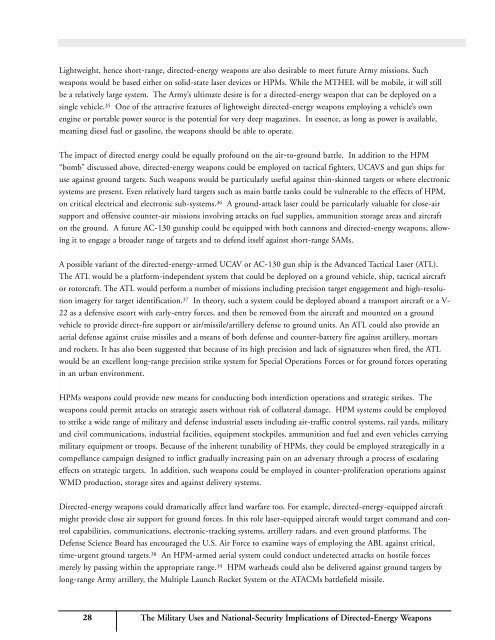directed-energy-weapons
directed-energy-weapons
directed-energy-weapons
Create successful ePaper yourself
Turn your PDF publications into a flip-book with our unique Google optimized e-Paper software.
Lightweight, hence short-range, <strong>directed</strong>-<strong>energy</strong> <strong>weapons</strong> are also desirable to meet future Army missions. Such<strong>weapons</strong> would be based either on solid-state laser devices or HPMs. While the MTHEL will be mobile, it will stillbe a relatively large system. The Army’s ultimate desire is for a <strong>directed</strong>-<strong>energy</strong> weapon that can be deployed on asingle vehicle. 35 One of the attractive features of lightweight <strong>directed</strong>-<strong>energy</strong> <strong>weapons</strong> employing a vehicle’s ownengine or portable power source is the potential for very deep magazines. In essence, as long as power is available,meaning diesel fuel or gasoline, the <strong>weapons</strong> should be able to operate.The impact of <strong>directed</strong> <strong>energy</strong> could be equally profound on the air-to-ground battle. In addition to the HPM“bomb” discussed above, <strong>directed</strong>-<strong>energy</strong> <strong>weapons</strong> could be employed on tactical fighters, UCAVS and gun ships foruse against ground targets. Such <strong>weapons</strong> would be particularly useful against thin-skinned targets or where electronicsystems are present. Even relatively hard targets such as main battle tanks could be vulnerable to the effects of HPM,on critical electrical and electronic sub-systems. 36 A ground-attack laser could be particularly valuable for close-airsupport and offensive counter-air missions involving attacks on fuel supplies, ammunition storage areas and aircrafton the ground. A future AC-130 gunship could be equipped with both cannons and <strong>directed</strong>-<strong>energy</strong> <strong>weapons</strong>, allowingit to engage a broader range of targets and to defend itself against short-range SAMs.A possible variant of the <strong>directed</strong>-<strong>energy</strong>-armed UCAV or AC-130 gun ship is the Advanced Tactical Laser (ATL).The ATL would be a platform-independent system that could be deployed on a ground vehicle, ship, tactical aircraftor rotorcraft. The ATL would perform a number of missions including precision target engagement and high-resolutionimagery for target identification. 37 In theory, such a system could be deployed aboard a transport aircraft or a V-22 as a defensive escort with early-entry forces, and then be removed from the aircraft and mounted on a groundvehicle to provide direct-fire support or air/missile/artillery defense to ground units. An ATL could also provide anaerial defense against cruise missiles and a means of both defense and counter-battery fire against artillery, mortarsand rockets. It has also been suggested that because of its high precision and lack of signatures when fired, the ATLwould be an excellent long-range precision strike system for Special Operations Forces or for ground forces operatingin an urban environment.HPMs <strong>weapons</strong> could provide new means for conducting both interdiction operations and strategic strikes. The<strong>weapons</strong> could permit attacks on strategic assets without risk of collateral damage. HPM systems could be employedto strike a wide range of military and defense industrial assets including air-traffic control systems, rail yards, militaryand civil communications, industrial facilities, equipment stockpiles, ammunition and fuel and even vehicles carryingmilitary equipment or troops. Because of the inherent tunability of HPMs, they could be employed strategically in acompellance campaign designed to inflict gradually increasing pain on an adversary through a process of escalatingeffects on strategic targets. In addition, such <strong>weapons</strong> could be employed in counter-proliferation operations againstWMD production, storage sites and against delivery systems.Directed-<strong>energy</strong> <strong>weapons</strong> could dramatically affect land warfare too. For example, <strong>directed</strong>-<strong>energy</strong>-equipped aircraftmight provide close air support for ground forces. In this role laser-equipped aircraft would target command and controlcapabilities, communications, electronic-tracking systems, artillery radars, and even ground platforms. TheDefense Science Board has encouraged the U.S. Air Force to examine ways of employing the ABL against critical,time-urgent ground targets. 38 An HPM-armed aerial system could conduct undetected attacks on hostile forcesmerely by passing within the appropriate range. 39 HPM warheads could also be delivered against ground targets bylong-range Army artillery, the Multiple Launch Rocket System or the ATACMs battlefield missile.28 The Military Uses and National-Security Implications of Directed-Energy Weapons


